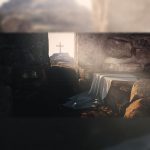Land of the Bible: Old Jerusalem
This series of "The Land of the Bible" deals with the Old City of Jerusalem. It begins with a panoramic view from the rooftops of its shops and houses and progresses to the Church of the Holy Sepulcher, the Mosque of Omar, the Greek Patriarchate, and the Citadel Museum of Jerusalem’s History concluding with a topographical map of Jerusalem. This video series serves as an orientation to Jerusalem and its multifaceted Jewish, Muslim, and Christian character.
Ep. 1 Rooftops of Jerusalem
This location at the very crossroads of the two axes of the Old City serves well to recognize the four sections of the city: the Christian Quarter, the Armenian Quarter, the Jewish Quarter, and the Moslem Quarter. The Mt of Olives ridge toward the east across the Kidron Valley is recognized by three towers:
1. The Hebrew University on Mt Scopus;
2. The Augusta Victoria Hospital in the saddle between the two mounts, and
3. The Church of the Ascension on the Mt of Olives.
The view from the roof also reveals the neighborhood of religious Jews who are living in formerly Jewish owned buildings in the Moslem Quarter, from which they were driven in 1927 and 1936.
Ep. 2 Church of the Holy Sepulcher
The visit to the church begins on its roof with the Coptic and Syrian Orthodox monasteries and then the monastery “village” of the Ethiopian monks. The dome on the roof is over the cave deep below what Helena, mother of Constantine, claimed to find the remnants of the cross.
Next is the chapel of the Ethiopian monks where a priest reads from a cross-shaped copy of the New Testament in the ancient Ge’ez language. The painting on leather is of the visit of the Queen of Sheba to Solomon (1 Kings 10:1-13). They view her as coming from the area of Ethiopia. The account of the Ethiopian and Philip is in Acts 8: 26-40.
Although originally constructed by Constantine around 330 AD, the present structure of the Church is from the Crusader period.
From the courtyard of the Church we view the front doors, one of which is blocked and the famous ladder leading from the lintel of the door to the window of the Armenian Chapel. This illustrates the rivalries that exist between the various groups within the Church. The keys to the church are actually in possession of two Moslem families in the Old City who come every morning to open the front door and at night to lock it. The rest of the entrances to the Church were blocked in the Turkish period.
The final scene is within the church immediately west of the traditional tomb where we examine some first century “shaft” (kokhim) burial niches. The other means of burial was a “shelf” (arcosolium), which was the type of burial for Jesus. That stone shelf is inside the edicule in the rotunda built over the traditional tomb of Jesus.
Ep. 3 Mosque of Omar
This brief section is of a mosque in front of the Holy Sepulcher that dates to the early Moslem conquest (ca 650 AD) built to commemorate the place where Omar prayed after the conquest of the city. The Dome of the Rock on the Temple Mount is often mistakenly called the Mosque of Omar. See HL, 62-63, who describes another mosque on the other side of the Holy Sepulcher. The minarets are higher than the dome of the church and they are equidistance from a point directly over the tomb; which “arrangement was intentional.”
Ep. 4 Greek Orthodox Patriarchate
One of the five patriarchs of the Orthodox Church, in addition to Alexandria, Antioch, Constantinople and Moscow. The library here has a number of ancient Greek NT manuscripts and holds the only surviving manuscript of the Didache, a church manual that dates from the first century. The manuscript, discovered in Constantinople, was copied in the 11th century AD.
Ep. 5 Christ Church and The Citadel
The Citadel actually was the site of the Turkish garrison (1517-1917). The highest tower is built on the base of the Phasael Tower, one of the three built by Herod the Great (the other two were called Hippicus and Mariamne).
Ep. 6 The Topography of Jerusalem
This map of the terrain around Jerusalem enables us to see the hills and valleys that compose the context of the city and environs. Be able to identify:
1. The three north south valleys: Kidron, Tyropeon, Hinnom;
2. Mt Scopus. Mt of Olives, Mt of Shame;
3. The east-west Transversal Valley;
4. Mt Moriah; and
5. Jebus/City of David/Ophel Ridge.
Ep. 7 Museum of the HIstory of Jerusalem, Part 1
A tour of the Museum of the History of Jerusalem. Part 1 includes a diorama of Jerusalem, Salem, and Old Testament Jerusalem prior to the building of the Temple under Solomon.
Ep. 8 Museum of the History of Jerusalem, Part 2
In part 2 of the Museum of the History of Jerusalem Dr. Will Varner discusses:
• The growth of Jerusalem from the City of David north to Mt Moriah and then to the western hill.
• The plan of Hezekiah’s Tunnel, its need, its construction, and its function.
• The return from captivity under Zerubbabel.
• The diorama of Ezra’s preaching at the “water gate” in Nehemiah 8
• The Second Temple Period or the Intertestamental Period or the 400 Silent Years.
• The diorama of the southeastern corner of the Herodian Temple, with the monumental staircase reconstructed from the evidence of the “springer” of stones on the wall known as “Robinson’s Arch.”
Ep. 9 Museum of the History of Jerusalem, Part 3
In part 3 of the Museum of the History of Jerusalem Dr. Will Varner discusses:
• The story of the destruction of the Temple in 70 AD and the exile of the Jewish people.
• A model of the inscription in the Temple warns Gentiles not to come further.
• A model of the inside of the Arch of Titus in Rome depicting the soldiers carrying away the spoils of the Temple.
• A small but detailed model of Jerusalem as it appeared in 70 AD.
• A bust of Hadrian recalls the revolt against Rome that was put down by the Romans (132-135 AD). Jerusalem was rebuilt as a pagan, de-Judaized city. The Byzantine Period followed (330-638 AD), a period marked by the building of churches.
• The section ends with a model of the Dome of the Rock that was built in 690 AD following the Muslim conquest in 630 AD. The Crusaders ruled for nearly a century until Muslim rule continued under the Mamelukes and Turks until the British rule began in 1918.
Ep. 10 Museum of the History of Jerusalem, Part 4
In part 4 of the Museum of the History of Jerusalem Dr. Will Varner discusses he Model of First Temple Jerusalem. He gives an explanation about the topography of the city, its walls, and the route of Hezekiah’s Tunnel.
Ep. 11 Museum of the History of Jerusalem, Part 5
In part 5 of the Museum of the History of Jerusalem a guide at the First Temple Model explains Jewish burial customs in the First Temple Period. The Dr. Varner discusses how the different burial customs of First and Second Temple periods help us understand the issue of where Jesus was buried – in the “Garden Tomb” (a First Temple tomb) or under the current Holy Sepulcher Church (where Second Temple tombs exist).
Ep. 12 Broad Wall
This brief section concerns the “Broad Wall” in the Jewish Quarter constructed by Hezekiah and possibly referred to by Nehemiah (3:8). Since this was the northern wall of the city and enemies usually encamped and attacked the city from the north, this is a possible location for the scene where the Rabshakeh called up to the people on the wall to surrender (2 Kings 18:17-37).
Other Series You May Like

The Risen King

The Promised King

